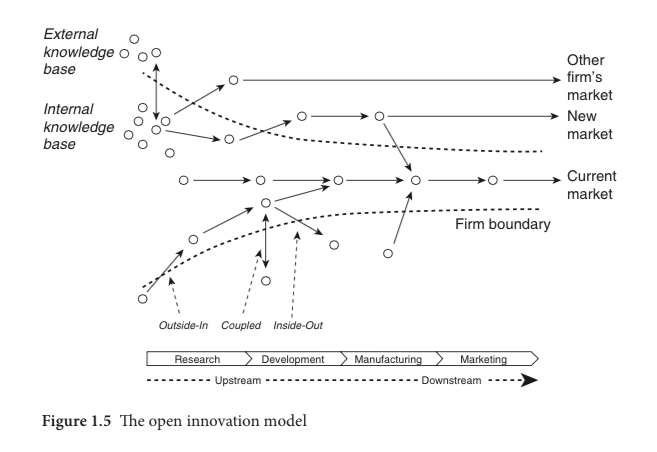Before assessing the three key models of open innovation, let’s take a step back and look at what open innovation means.
Henry Chesbrough, who first coined the term open innovation, notes that:
“At the most fundamental level, open innovation is embedded in the notion that the sources of knowledge for innovation are widely distributed in the economy.”
Chesbrough is referring, of course, to all the new solutions, ideas, creative business models, industry reports, thought leaders and whatever else your organization considers invaluable for its survival.
So that’s what open innovation means. Let’s now focus on the interesting bit: how it’s actually done.
Open innovation theory refers to three different models, depending on the direction of the knowledge flow that you or your organization wish to leverage:
- Outside-in open innovation (or inbound knowledge flow)
- Inside-out (or outbound knowledge flow)
- Coupled open innovation (combining knowledge inflows and outflows)
 (source: H. Chesbrough, W. Vanhaverbeke and J. West – New Frontiers in Open Innovation, 2014)
(source: H. Chesbrough, W. Vanhaverbeke and J. West – New Frontiers in Open Innovation, 2014)
Let’s look at some examples of each.
Outside-in open innovation model
People in companies utilizing the outside-in open innovation model are completely immersed in the mindset of their external communities and customers. These types of companies are constantly looking for ways to expand their current demand.
Outside-in companies’ sustainable growth strategies start with understanding the difference between what you make and what people need – which often turns out not to be the same thing.
Typically, an outside-in organization asks itself the following:
- Where are the growth markets for our business?
- How can we tap into an available opportunity?
- What are the trends and how should we meet them?
- How can we better serve the needs of the market?
Here are some examples of the different approaches to the outside-in innovation model.
Corporate start-up collaboration
Corporate start-up collaborations bring many benefits to everyone involved, from specific business units to C-level executives, investors, and, of course, to the start-up itself.
It’s easy to see why corporate partnerships with start-ups make sense: Start-ups can benefit from corporate funding, resources, and customer access, while corporations need to innovate to stay ahead of competitors and disruption, and to access new technology.
Companies like INNOSPOT make it very easy to find the ideal start-ups to partner with and to manage the relationship.
Supplier-sourced innovation
A growing number of companies are looking outside of their organization to support their innovation initiatives. And suppliers are one of the first sources that spring to mind given the shared common goal of mutual success. If all supply-chain partners are aligned on the value they wish to create together, suppliers can help solve problems that no single organization can solve on its own.
Your supply chain is a huge network of external people, processes, and information. Platforms like HYPE Innovation make it easy to bring together all the stakeholders in your supply chain and every contributor in one centralized platform.
The outcome? Increased speed-to-market, improved innovation program capacity, and better performance overall.
External knowledge and trends
Reports, industry news, and research papers are all great sources of knowledge that can inform your innovation efforts and help to guide where your company should be focusing to come up with new solutions and ideas.
Using a tool like HYPE Strategy enables companies to easily tap into the vast source of knowledge that sits outside of their organization, analyze signals such as the latest trends in the market, and discover new technologies and groundbreaking research. It’s super easy to collaborate with all of your colleagues, involve them in the foresight process and then cluster all the signals into potential opportunities and strategic roadmaps for your business.
In-licensing IP
If you want to use another company's innovative solution to develop your own business and products, you can “license in” their IP.
This approach also applies across industries. For example, to acquire the right to make “The Lord of the Rings” trilogy, movie director Peter Jackson needed a license from the Saul Zaentz Company, which holds movie rights to J. R. R. Tolkien’s work.
University cooperation
University and business collaboration can achieve amazing innovation outcomes. These types of collaborations can boost not only the businesses themselves, but the economy too, and can potentially contribute to solving global challenges.
Universities hold public knowledge across research, teaching, and innovation. This is what makes the value of collaborating with them significant, sustainable, and widespread across society.
Collaboration with universities can take many forms, for example through research, consultancy, science park developments, and co-developing curricula or apprenticeships.
Inside-out open innovation model
In contrast to outside-in innovation, the inside-out approach is guided by the belief that the inner strengths and capabilities of an organization will generate its sustainable future.
This approach starts with what an organization possesses before looking at anything else. It raises questions relating to what the organization has in terms of core competencies, talent, resources, and customer relationships, and assesses how these can be leveraged.
Typically, an inside-out organization asks itself:
- How have we progressed or regressed over the last few years?
- What are we good at?
- What do we love to do?
- What are we passionate about?
- What do we represent?
- How do we leverage our strengths and compensate or eliminate our weaknesses?
Continuous improvement
The most common way to open your innovation efforts is by engaging your entire workforce and asking them how to improve processes, increase productivity, or reduce costs.
By tapping into the minds of your internal workforce, you can uncover the best practices that are already happening and that could potentially be adapted to other areas of your business. By asking your employees about potential ways to improve and empowering them to participate, you give everyone a platform to voice their ideas, and you’ll discover the most unexpected ideas in the most unexpected corners of your organization.
Platforms like HYPE Ideation are designed to make the process of continuous improvement systematic, strategic, and measurable. You can ask your workforce to submit ideas on specific challenges or you can simply give them a place where they can voice their ideas whenever they come up.
Intrapreneurship
The idea behind intrapreneurship is that the person who comes up with an idea is best placed to make that idea a reality.
Intrapreneurship has many benefits for organizations, including motivating employees, solving problems internally, and achieving competitive advantages. It also offers great benefits to employees in terms of helping them to grow professionally as well as personally.
Why don’t you try it out? Don’t stop at asking for your employee’s ideas – empower them to make those ideas a reality.
Corporate incubators
Because of their significant advantage of utilizing internal assets that already exist, corporate incubators are growing in popularity worldwide as a great way to supercharge innovation and encourage entrepreneurial spirit.
Coupled open innovation
The best organizations skillfully employ both outside-in and inside-out innovation. They are mindful of where their strengths are and where there are gaps in their approach to innovation while using their organizational “radars” to detect opportunities or threats. These organizations know that the most effective business strategies need to consider both internal practicalities and external factors.
Customer insight and feedback
Listening to the voice of the customer helps companies to identify gaps and seize opportunities that best meet customers’ needs. The insights gathered through customer feedback support not just product innovation and development, but also customer experience, messaging, sales and marketing, and customer service.
However, keep in mind that you should never ask your customers what new products they want. Why? As Henry Ford said, "If I had asked people what they wanted, they would have said faster horses.” Ask them what problem they want you to solve, or how they want you to make them feel. How you are going to provide this to them must come from your own R&D processes.
So incorporate your customer insights and feedback into your R&D processes rather than trusting this knowledge flow as a single source of truth. It still needs to be interpreted by the people who are aware of the latest innovations and where the world is moving.
Strategic partnerships and joint ventures
As the saying goes, if you want to go fast – go alone, and if you want to go far – go together. That’s why forming a strategic partnership between two or more businesses can bring enormous value to each organization and help them grow toward their mutual goal. These partnerships usually take the form of agreement between two or more organizations on a mutually beneficial project or goal, for instance, to cooperate in the manufacturing or sales processes.
The Lipton and PepsiCo venture is a great example of using open innovation to create a sustainable partnership to produce tea in a ready-to-drink (RTD) format.
Networks and ecosystems
Networks and ecosystems are other examples of coupled open innovation, involving complementary partners brought together by shared values, a shared mission, and a mutual vision for new innovative solutions.
While innovation ecosystems are arguably the most sophisticated vehicles for open innovation, collaboration, and impact generation, creating an open innovation ecosystem isn’t rocket science once you map out all your stakeholders and find the right partners to work with. Platforms like HYPE Innovation enable you to build and manage the full lifecycle of your innovation ecosystem to empower your entire organization to innovate in a strategic, scalable, and integrated way.
So, there you have it - a comprehensive introduction to the various models of open innovation. I hope you found it helpful!










